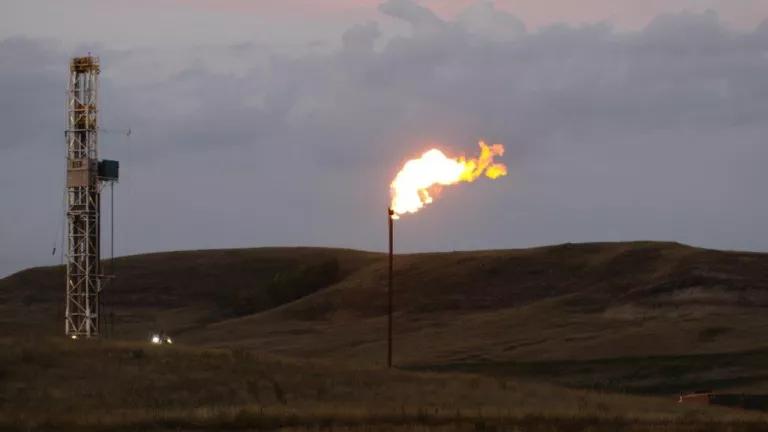Report: The Oil and Gas Leasing Pause Has Minimal Impact
In a newly released report—commissioned by NRDC in partnership with the Center for Western Priorities and eight other groups—the Conservation Economics Institute (CEI) finds that the temporary moratorium on leasing public lands for oil and gas development has negligible economic effects and that oil industry claims of doom was nothing but hyperbole.

Methane flare at oil and gas well.
In a newly released report—commissioned by NRDC in partnership with the Center for Western Priorities and eight other groups—the Conservation Economics Institute (CEI) finds that the temporary moratorium on leasing public lands for oil and gas development has negligible economic effects and that oil industry claims of doom was nothing but hyperbole.
On January 27, 2021, President Biden issued a sweeping executive order aimed at reinvigorating the United States’ response to the climate crisis. As part of that order, the administration suspended federal oil and gas leasing on public lands and ocean waters temporarily, pending a Department of the Interior (DOI) review of the onshore and offshore federal oil and gas programs. That review process kicked off with a public forum on March 25, 2021, where representatives from Indigenous tribes to industry to front line community members presented their perspectives on the oil and gas programs.
The temporary pause on federal oil and gas leasing prompted industry players and their trade associations to stoke the spin machine into overdrive. They called it Armageddon for oil and gas workers and fossil-dependent state economies.
The facts debunk those claims.
In their analysis, CEI looked at places in the U.S. with the largest shares of onshore federal oil and gas leasing, identifying employment trends and drivers in those geographies, and analyzing potential economic effects—positive or negative—of a temporary public lands leasing moratorium. Their results confirmed what those who follow the evolution of western economies and oil and gas markets closely sensed to be true from the earliest days of DOI’s pause in leasing. Namely, that temporarily stopping federal onshore leasing has little, if any, near-term impact on either production of oil and gas from federal lands or employment, even in the most fossil-dependent states of New Mexico and Wyoming.
Here are five key reasons CEI found negligible national and state level economic impacts from a temporary federal oil and gas leasing moratorium:
- The share of oil and gas produced from federal public lands is quite small, representing 6 percent of total domestic oil and 8 percent of total domestic gas
- The pause on federal leasing was not a pause on either existing production and drilling, or the issuance of permits to drill
- The well-documented stockpile of unused and undeveloped onshore oil and gas leases—amounting to 14 million acres—provides industry with access areas that could support, at a macro level, up to 75 years of future drilling opportunities if the pace of development remains the same as current rates
- The five western states—Colorado, Montana, New Mexico, Utah, and Wyoming—that are home to most federal oil and gas production (86 percent and 95 percent, respectively), have increasingly diversified economies where oil and gas employment is on the decline while sectors like IT, services, government, and tourism are all powerful economic drivers
- Oil and gas employment has no correlation to federal public lands leasing; though oil and gas employment has been on a general decline for many years (regardless of administration), global oil prices remain the best predictor for the state of oil and gas employment in the states examined
The Intermountain West has been moving away from its dependence on extractive industry for years. CEI’s report confirms that trend is as true for the oil and gas industry as it has been for other industries like mining and logging.
But CEI’s work also shines attention on the more meaningful and important conversations we should be having about oil and gas and the future vitality of western economies. Namely, that there is tremendous value in conservation—both in attracting businesses and people to new areas and in advancing critical goals like species protection, pollution abatement, and clean water conservation. Pausing leasing gives the Administration a chance to take stock of the leasing program in this larger context and update it to reflect today’s realities. And the bottom line remains that expanding oil and gas development—be it on federal lands or state and private lands—threatens a climate safe future, and we need to be looking at these areas for the economies they can support and the values they hold in a feature free from fossil fuel development and use.




